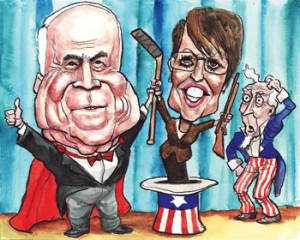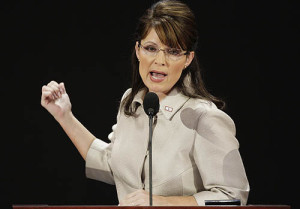Second-Place Citizens
By SUSAN FALUDI
Published: The New York Times, August 25, 2008
San Francisco
MUCH has been made of the timing of Hillary Clinton’s speech before the Democratic National Convention tonight, coming as it does on the 88th anniversary of women’s suffrage. Convention organizers are taking advantage of this coincidence of the calendar — the 19th Amendment was certified on Aug. 26, 1920 — to pay homage to the women’s vote in particular and women’s progress in general. By such tributes, they are slathering some sweet icing on a bitter cake. But many of Mrs. Clinton’s supporters are unlikely to be partaking. They regard their candidate’s cameo as a consolation prize. And they are not consoled.
“I see this nation differently than I did 10 months ago,” reads a typical posting on a Web site devoted to Clintonista discontent. “That this travesty was committed by the Democratic Party has forever changed my approach to politics.” In scores of Internet forums and the conclaves of protest groups, those sentiments are echoed, as Clinton supporters speak over and over of feeling heartbroken and disillusioned, of being cheated and betrayed.
In one poll, 40 percent of Mrs. Clinton’s constituency expressed dissatisfaction; in another, more than a quarter favored the clear insanity of voicing their feminist protest by voting for John McCain. “This is not the usual reaction to an election loss,” said Diane Mantouvalos, the founder of JustSayNoDeal.com, a clearinghouse for the pro-Clinton organizations. “I know that is the way it is being spun, but it’s not prototypical. Anyone who doesn’t take time to analyze it will do so at their own peril.”
The despondency of Mrs. Clinton’s supporters — or their “vitriolic” and “rabid” wrath, as the punditry prefers to put it — has been the subject of perplexed and often irritable news media speculation. Why don’t these dead-enders get over it already and exit stage right?
Shouldn’t they be celebrating, not protesting? After all, Hillary Clinton’s campaign made unprecedented strides. She garnered 18 million-plus votes, and proved by her solid showing that a woman could indeed be a viable candidate for the nation’s highest office. She didn’t get the gold, but in this case isn’t a silver a significant triumph?
Many Clinton supporters say no, and to understand their gloom, one has to take into account the legacy of American women’s political struggle, in which long yearned for transformational change always gives way before a chorus of “not now” and “wait your turn,” and in which every victory turns out to be partial or pyrrhic. Indeed, the greatest example of this is the victory being celebrated tonight: the passage of women’s suffrage. The 1920 benchmark commemorated as women’s hour of glory was experienced in its era as something more complex, and darker.
Suffrage was, like Hillary Clinton’s candidacy, not merely a cause in itself, but a symbolic rallying point, a color guard for a regiment of other ideas. But while the color guard was ushered into the palace of American law, its retinue was turned away.
In the years after the ratification of suffrage, the anticipated women’s voting bloc failed to emerge, progressive legislation championed by the women’s movement was largely thwarted, female politicians made only minor inroads into elected office, and women’s advocacy groups found themselves at loggerheads. “It was clear,” said the 1920s sociologist and reformer Sophonisba Breckinridge, “that the winter of discontent in politics had come for women.”
That discontent was apparent in a multitude of letters, speeches and articles. “The American woman’s movement, and her interest in great moral and social questions, is splintered into a hundred fragments under as many warring leaders,” despaired Frances Kellor, a women’s advocate.
“The feminist movement is dying of partial victory and inanition,” lamented Lillian Symes, a feminist journalist.
“Where for years there had been purpose consecrated to an immortal principle,” observed the suffrage leader Carrie Chapman Catt, her compatriots felt now only “a vacancy.”
Even Florence Kelley, the tenacious progressive reformer, concluded, “Keeping the light on is probably the best contribution that we can make where there is now Stygian darkness.”
The grail of female franchise yielded little meaningful progress in the years to follow. Two-thirds of the few women who served in Congress in the 1920s were filling the shoes of their dead husbands, and most of them failed to win re-election. The one woman to ascend to the United States Senate had a notably brief career: in 1922, Rebecca Felton, 87, was appointed to warm the seat for a newly elected male senator until he could be sworn in. Her term lasted a day.
Within the political establishment, women could exact little change, and the parties gave scant support to female politicians. In 1920, Emily Newell Blair, the Democratic vice chairwoman, noted that the roster of women serving on national party committees looked like a “Who’s Who” of American women; by 1929, they’d been shown the door and replaced with the compliant. The suffragist Anne Martin bitterly remarked that women in politics were “exactly where men political leaders wanted them: bound, gagged, divided and delivered to the Republican and Democratic Parties.”
Male politicians offered a few sops to feminists: a “maternity and infancy” bill to educate expectant mothers, a law permitting women who married foreigners to remain American citizens, and financing for the first federal prison for women. But by the mid ’20s, Congress had quit feigning interest, and women’s concerns received a cold shoulder. In 1929, the maternity education bill was killed.
Meanwhile, male cultural guardians were giving vent to what Symes termed “the new masculinism” — diatribes against the “effeminization” that had supposedly been unleashed on the American arts. The news media proclaimed feminism a dead letter and showcased young women who preferred gin parties to political caucuses.
During the presidential race of 1924, newspapers ran headlines like “Woman Suffrage Declared a Failure.” “Ex-feminists” proclaimed their boredom with “feminist pother” and their enthusiasm for cosmetics, shopping and matrimony. The daughters of the suffrage generation were so beyond the “zealotry” of their elders, Harper’s declared in its 1927 article “Feminist — New Style,” that they could only pity those ranting women who were “still throwing hand grenades” and making an issue of “little things.”
Those “little things” included employment equity, as a steady increase in the proportion of women in the labor force ground to a halt and stagnated throughout the ’20s. Women barely improved their representation in male professions; the number of female doctors actually declined.
“The feminist crash of the ’20s came as a painful shock, so painful that it took history several decades to face up to it,” the literary critic Elaine Showalter wrote in 1978. Facing it now is like peering into a painful mirror. For all the talk of Hillary Clinton’s “breakthrough” candidacy and other recent successes for women, progress on important fronts has stalled.
Today, the United States ranks 22nd among the 30 developed nations in its proportion of female federal lawmakers. The proportion of female state legislators has been stuck in the low 20 percent range for 15 years; women’s share of state elective executive offices has fallen consistently since 2000, and is now under 25 percent. The American political pipeline is 86 percent male.
Women’s real annual earnings have fallen for the last four years. Progress in narrowing the wage gap between men and women has slowed considerably since 1990, yet last year the Supreme Court established onerous restrictions on women’s ability to sue for pay discrimination. The salaries of women in managerial positions are on average lower today than in 1983.
Women’s numbers are stalled or falling in fields ranging from executive management to journalism, from computer science to the directing of major motion pictures. The 20 top occupations of women last year were the same as half a century ago: secretary, nurse, grade school teacher, sales clerk, maid, hairdresser, cook and so on. And just as Congress cut funds in 1929 for maternity education, it recently slashed child support enforcement by 20 percent, a decision expected to leave billions of dollars owed to mothers and their children uncollected.
Again, male politicians and pundits indulge in outbursts of “new masculinist” misogyny (witness Mrs. Clinton’s campaign coverage). Again, the news media showcase young women’s “feminist — new style” pseudo-liberation — the flapper is now a girl-gone-wild. Again, many daughters of a feminist generation seem pleased to proclaim themselves so “beyond gender” that they don’t need a female president.
As it turns out, they won’t have one. But they will still have all the abiding inequalities that Hillary Clinton, especially in defeat, symbolized. Without a coalescing cause to focus their forces, how will women fight a foe that remains insidious, amorphous, relentless and pervasive?
“I am sorry for you young women who have to carry on the work in the next 10 years, for suffrage was a symbol, and you have lost your symbol,” the suffragist Anna Howard Shaw said in 1920. “There is nothing for women to rally around.” As they rally around their candidate tonight, Mrs. Clinton’s supporters will have to decide if they are mollified — or even more aggrieved — by the history she evokes.
Susan Faludi is the author, most recently, of “The Terror Dream: Myth and Misogyny in an Insecure America.”

